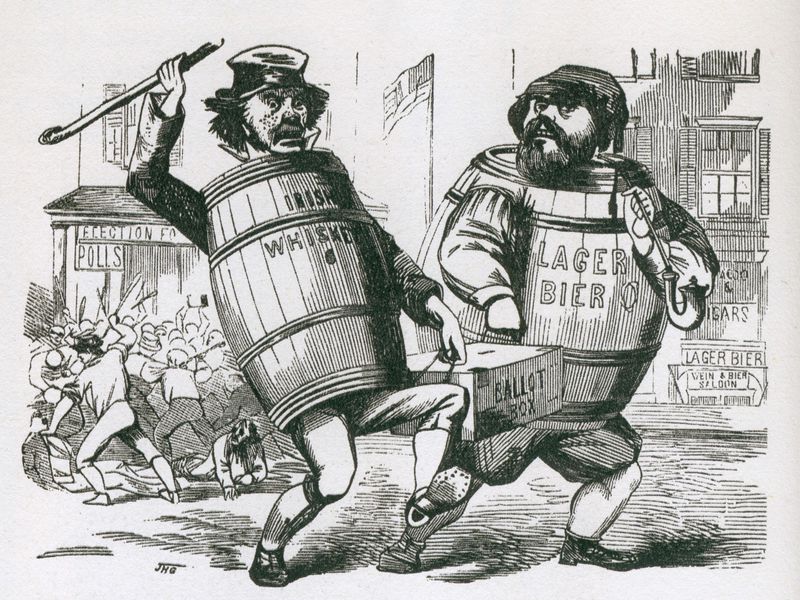|
One of the major themes of the AP® US History course is migration and settlement. In order to help students prepare for the APUSH exam, I have created a two page review sheet with notes on immigration and internal migrations from the pre-colonial period to the present. Click here to download my APUSH Immigration Review Notes. (PDF Format) Native Migrations ("1491")Around 15,000 years ago, small human populations from Siberia migrated across the Bering Land Bridge. Over thousands of years, these groups spread across North America and developed into several distinct language and culture groups. Exploration and Colonization (1492-1776)European colonizers settled in different regions in North America, with the Spanish settling in the American Southwest and Florida, the French in the Great Lakes region and Louisiana, the Dutch in present-day New York, and the English on the Eastern Seaboard. Of these colonizers, only the English sent large numbers of settlers. During this period, over 300,000 African slaves were brought to North America via the infamous Middle Passage across the Atlantic. Early National America (1776-1820)European settlers during the early national period came primarily from Northwestern Europe (England, Scotland, Germany, and Scandinavia). These settlers were overwhelmingly Protestant. After American independence, 300,000 more African slaves were brought to the United States before Congress ended the African slave trade in 1808. Antebellum Period (1820-1860)In the 1820s, thousands of Anglo-American settlers, mostly from the South, began settling in Texas, which was part of Mexico. In the 1830s, conflicts between these settlers and the Mexican government resulted in Texas declaring its independence in 1836. The 1830 Indian Removal Act resulted in the (often forced) relocation of around 60,000 Native Americans from the South to the Indian Territory (Oklahoma). Thousands died on what became known as the Trail of Tears.
The Wild West (1840-1890)During the 1840s, the height of Manifest Destiny, thousands of American pioneers ventured to the American West on the Oregon, Mormon, and California Trails. The 1849 Gold Rush made California a popular destination for Americans hoping to strike it rich. The Gold Rush also attracted Chinese immigrants, who settled in San Francisco and prospected for gold. In the 1860s, Chinese made up the bulk of the workforce that constructed the Central Pacific Railroad. NATIVISM: The Chinese Exclusion Act (1882), which banned further immigration from China, was the first law passed in the United States to limit immigration. A 1907 “Gentleman’s Agreement” between the United States and Japan limited Japanese immigration without the United States passing a law. The Progressive Era (1890-1920)In the 1890s, as the United States was in the midst of unprecedented industrialization and urbanization, “New Immigrants” arrived in droves from Southern and Eastern Europe (e.g., Italy, Poland, Greece, and Russia). In addition to Italian and Polish Catholics, this represented the first large wave of Jewish and Orthodox Christian immigrants. NATIVISM: The New Immigrants did not get a particularly warm welcome in the United States because they did not tend to speak English, came from countries with little to no experience with republican institutions, and often lacked education and job skills. Progressive reformers worked to culturally assimilate the New Immigrants into an American “melting pot.” The settlement house movement, led by people like Jane Addams (of the Hull House), sought to give immigrants job and language skills. Public education became more focused on citizenship and acquainting new immigrants with the American way of life. Post-WWI (1920s)The (First) Red Scare, which followed the Bolshevik Revolution, was a panic about immigration rooted in fear that immigrants would start a communist revolution in the United States. The Palmer Raids resulted in the deportation of hundreds of immigrants who held radical political views. The Great Migration of African Americans from the South began during World War I, as black men sought jobs in Northern cities and eventually brought their families with them. Unfortunately, many of those trying to escape racism in the South found it in the North in the form of brutal race riots in Chicago and other cities. NATIVISM MEETS RACISM: The (Second) Ku Klux Klan reached its peak membership in the mid-1920s, inspired by the silent film, Birth of a Nation, which glamorized the activities of the (First) Ku Klux Klan during Reconstruction. The Ku Klux Klan was as nativist as it was racist, promoting an idea of America that was white, native, and Protestant (WASP). Congress passed Immigration Quota Acts during the 1920s, which laid the foundation for a system of controlled immigration. Quotas, based on national origins, gave preference to immigrants from Northern and Western Europe. The Sacco and Vanzetti Trial was a polarizing event in the 1920s. When Sacco and Vanzetti were found guilty of a murder and armed robbery, Italian-Americans cried foul, claiming that the guilty verdict was based on the defendants’ national origins and anarchist politics. Contemporary America (1960-Present)In the decades following WWII, there was a sustained internal migration to the warm climates of the sun belt (from the Carolinas to California) because of the availability of air conditioning and cheaper (and often less regulated) labor. In the 1960s, national origins quotas were modified in order to encourage more immigration from the developing world - especially from Asia, Africa, and the Middle East - and eliminating preferences for white immigrants. The 1965 act also gave preference to educated immigrants who possessed specialized job skills (e.g., doctors, chemists), immigrants who already had relatives in the United States, and refugees. The Immigration Act of 1990 lifted restrictions against homosexual immigrants, who had been classified among “sexual deviants” in the 1965 Immigration Act. AP® is a trademark registered by the College Board, which is not affiliated with, and does not endorse, this product.
0 Comments
|
Tom RicheyI teach history and government Archives
May 2023
Categories
All
|



 RSS Feed
RSS Feed